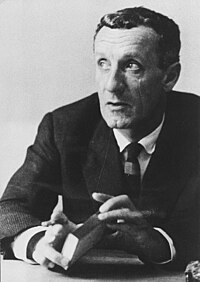
Photo from wikipedia
Abstract This paper proposes reading the sense of senses in Maurice Merleau-Ponty’s first work La Structure du comportement in view of positioning language as the sixth sense. La Structure du… Click to show full abstract
Abstract This paper proposes reading the sense of senses in Maurice Merleau-Ponty’s first work La Structure du comportement in view of positioning language as the sixth sense. La Structure du comportement precedes his best-known work Phénoménologie de la perception1 and shows in an exemplary way that language and expression are preceded by a sense of a whole in which the expression is placed. In his first book, Merleau-Ponty is heavily indebted to Gestalttheorie and he is preoccupied with the refutation of René Descartes. The sense of a whole, named form taken from Gestalt in this first book and later named chaire, serves for the refutation of Cartesian philosophy summarized in two points of Atomism and Dualism. La Structure du comportement focuses on gestures or bodily mobility as the pre-stage of perception, in which body and mind and also language are already blended. By examining symbols or naturally founded non-arbitrary signs from animals to man, Merleau-Ponty analyzes human language as symbols by referring to examples drawn from music, painting, and literature. In this sphere of symbols, philosophy and literature are identical but belong to a different whole or form.
Journal Title: Contemporary French and Francophone Studies
Year Published: 2018
Link to full text (if available)
Share on Social Media: Sign Up to like & get
recommendations!